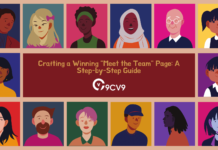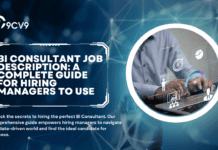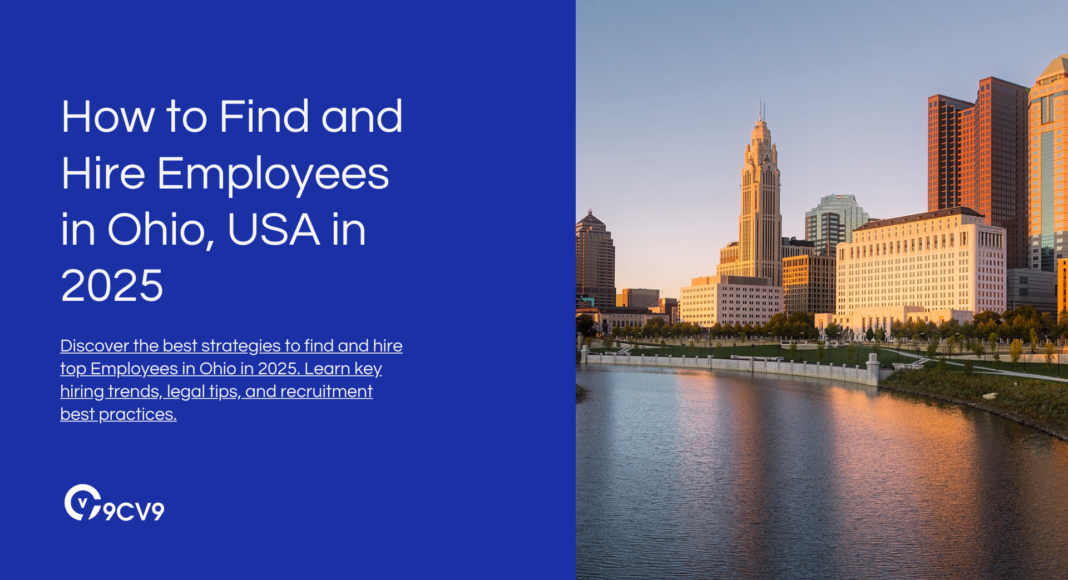Key Takeaways
- Leverage diverse hiring channels – Utilize job portals like 9cv9, recruitment agencies, and local networking events to find top talent in Ohio.
- Stay compliant with hiring laws – Ensure adherence to Ohio’s employment regulations, including wage laws, background checks, and equal opportunity policies.
- Enhance employer branding – Offer competitive salaries, flexible work options, and a strong company culture to attract and retain skilled employees.
The hiring landscape in Ohio, USA, is evolving rapidly as businesses navigate new economic conditions, technological advancements, and shifting workforce expectations.
With 2025 marking another pivotal year for the labor market, companies across industries must adopt strategic approaches to attract and retain top talent.
Whether you are a small business owner looking for your first employees or a large corporation expanding your workforce, understanding Ohio’s hiring trends, job market dynamics, and best recruitment practices is essential for long-term success.

As one of the fastest-growing business hubs in the Midwest, Ohio offers a diverse talent pool across key sectors such as manufacturing, healthcare, technology, finance, and logistics.
However, competition for skilled professionals is intensifying, making it crucial for employers to refine their recruitment strategies.
With the rise of remote and hybrid work models, companies now have access to a broader range of candidates, but they must also contend with new expectations for flexibility, benefits, and career growth opportunities.
Additionally, economic fluctuations, evolving labor laws, and technological disruptions are reshaping the way organizations approach hiring, requiring employers to stay agile and proactive in their recruitment efforts.
One of the biggest challenges businesses face in 2025 is ensuring they reach the right candidates through the most effective channels.
Traditional hiring methods, such as job fairs and classified ads, are being supplemented—or even replaced—by AI-driven recruitment tools, social media hiring, and specialized job platforms.
At the same time, employers must navigate complex labor regulations, including wage laws, equal employment opportunity requirements, and work authorization processes, to ensure compliance and avoid potential legal pitfalls.
Moreover, the expectations of job seekers in Ohio have shifted significantly in recent years. Employees are increasingly looking for roles that offer not only competitive salaries but also meaningful career growth, work-life balance, and strong company cultures.
Businesses that fail to adapt to these changing preferences risk losing top candidates to competitors who offer better benefits, flexible work arrangements, and professional development opportunities.
Additionally, the emphasis on diversity, equity, and inclusion (DEI) continues to grow, making it imperative for employers to build inclusive workplaces that attract a wide range of talent.
To successfully find and hire employees in Ohio in 2025, businesses need a well-rounded strategy that includes leveraging online job platforms, tapping into professional networks, working with staffing agencies, and utilizing modern recruitment technologies.
Understanding local workforce trends, offering competitive compensation packages, and streamlining the hiring process can help organizations secure the best talent in an increasingly competitive market.
In this guide, we will explore the most effective ways to find and recruit employees in Ohio, covering essential aspects such as the current job market outlook, sourcing strategies, hiring best practices, legal considerations, and future trends.
Whether you are looking to fill entry-level positions or hire senior executives, this comprehensive resource will provide actionable insights to help you build a strong workforce and achieve long-term business success in Ohio.
Before we venture further into this article, we would like to share who we are and what we do.
About 9cv9
9cv9 is a business tech startup based in Singapore and Asia, with a strong presence all over the world.
With over nine years of startup and business experience, and being highly involved in connecting with thousands of companies and startups, the 9cv9 team has listed some important learning points in this overview of How to Find and Hire Employees in Ohio, USA in 2025.
If your company needs recruitment and headhunting services to hire top-quality employees, you can use 9cv9 headhunting and recruitment services to hire top talents and candidates. Find out more here, or send over an email to [email protected].
Or just post 1 free job posting here at 9cv9 Hiring Portal in under 10 minutes.
How to Find and Hire Employees in Ohio, USA in 2025
- Understanding Ohio’s Job Market in 2025
- Where to Find Qualified Candidates in Ohio
- How to Attract Top Talent in Ohio
- The Hiring Process: Step-by-Step Guide
- Legal Considerations When Hiring in Ohio
- Future Trends in Hiring in Ohio
1. Understanding Ohio’s Job Market in 2025
Ohio’s job market in 2025 continues to evolve, driven by industry trends, economic factors, technological advancements, and workforce demographics. Businesses looking to hire employees in Ohio must stay informed about these changes to attract top talent effectively. From high-growth industries to workforce challenges, understanding the hiring landscape can help employers create better recruitment strategies and stay competitive in the talent market.
Key Employment Trends in Ohio for 2025
- Growth in Technology and Innovation
- Ohio is emerging as a technology hub, with increased job opportunities in IT, software development, cybersecurity, and artificial intelligence.
- Major cities like Columbus, Cincinnati, and Cleveland are attracting tech startups and enterprises, creating a surge in demand for skilled professionals.
- Companies such as Intel have invested in semiconductor manufacturing in Ohio, leading to new job opportunities in engineering, research, and advanced manufacturing.
- Strong Demand in Healthcare and Life Sciences
- Ohio’s aging population is driving demand for healthcare professionals, including registered nurses, medical technicians, and home healthcare aides.
- Major hospitals and research institutions, such as the Cleveland Clinic and Ohio State University Wexner Medical Center, are expanding their workforce.
- Pharmaceutical and biotechnology companies are investing in Ohio, contributing to job growth in research, clinical trials, and biotech manufacturing.
- Manufacturing Sector Reinvention
- Advanced manufacturing is on the rise, with automation and smart manufacturing creating new job opportunities for skilled technicians and engineers.
- Ohio remains a leader in automotive and aerospace manufacturing, with companies like Honda and Boeing investing in high-tech production facilities.
- The push for sustainability is leading to more jobs in green manufacturing and renewable energy production.
- Boom in Logistics and E-commerce
- Ohio’s strategic location makes it a critical hub for logistics, warehousing, and distribution.
- Companies like Amazon, FedEx, and UPS continue expanding their operations, leading to more job openings in supply chain management and transportation.
- Automation and AI-powered logistics solutions are changing the skill requirements for workers in this sector.
- Expansion of Remote and Hybrid Work Models
- Many Ohio-based companies are offering remote or hybrid work options to attract talent from across the country.
- Industries such as marketing, finance, IT, and customer service are seeing a shift towards flexible work arrangements.
- Employers who provide work-from-home options tend to attract more candidates, particularly younger professionals seeking better work-life balance.
Workforce Demographics and Labor Market Changes
- Increasing Workforce Diversity
- Ohio’s workforce is becoming more diverse, with growing participation from women, minorities, and immigrant workers.
- Employers are focusing on diversity, equity, and inclusion (DEI) initiatives to attract and retain a broader range of talent.
- Companies offering inclusive workplaces and equitable career growth opportunities are seeing higher employee retention rates.
- Aging Workforce and Talent Shortages
- Many industries, including healthcare and skilled trades, are facing labor shortages due to an aging workforce.
- Employers are investing in workforce development programs to train younger workers in high-demand fields.
- Apprenticeship and vocational training programs are gaining popularity as alternatives to traditional college degrees.
- Rising Expectations for Employee Benefits
- Job seekers in Ohio are prioritizing employers who offer competitive salaries, health benefits, and professional development opportunities.
- Flexible work arrangements, wellness programs, and student loan assistance are becoming key factors in attracting talent.
- Companies that fail to offer attractive compensation packages are struggling to fill open positions.
Economic Factors Impacting Hiring in Ohio
- Statewide Economic Growth
- Ohio’s economy is projected to continue growing in 2025, fueled by investments in manufacturing, technology, and infrastructure.
- Public and private partnerships are boosting job creation across multiple sectors.
- Impact of Inflation and Wage Increases
- Rising living costs and inflation are pushing employers to offer higher wages to attract talent.
- The state’s minimum wage has been increasing gradually, affecting hiring budgets for small businesses.
- Companies are balancing competitive salaries with cost-saving measures such as automation and AI-driven processes.
- Government Incentives for Employers
- Ohio offers tax incentives and grants to businesses that create jobs and invest in workforce development.
- Programs such as TechCred and JobsOhio provide financial support for training employees in high-demand industries.
- Employers who participate in these initiatives can reduce hiring costs and improve workforce readiness.
Regulatory and Labor Law Considerations
- Wage and Hour Regulations
- Employers must comply with Ohio’s minimum wage laws, which are subject to annual adjustments.
- Overtime regulations and worker classification rules are critical to avoid legal issues.
- Work Authorization and Employment Eligibility
- Companies hiring in Ohio must ensure employees have valid work authorization and comply with E-Verify requirements.
- Hiring international talent requires adherence to visa sponsorship laws and federal employment guidelines.
- Anti-Discrimination and Equal Opportunity Laws
- Employers must follow federal and state laws that prohibit discrimination in hiring and employment practices.
- Implementing fair hiring policies and diverse recruitment strategies helps businesses stay compliant and attract top talent.
Conclusion
Ohio’s job market in 2025 presents both opportunities and challenges for employers looking to hire skilled professionals. With a dynamic economy, shifting workforce demographics, and evolving job trends, businesses must adapt their hiring strategies to remain competitive. Understanding industry demands, economic factors, labor laws, and employee expectations can help organizations attract the right talent and build a strong, future-ready workforce. By staying informed and leveraging the right recruitment approaches, employers in Ohio can successfully navigate the hiring landscape and secure top candidates for their teams.
2. Where to Find Qualified Candidates in Ohio
Finding top talent in Ohio requires employers to use a combination of traditional and modern recruitment strategies. With a competitive job market and evolving workforce expectations, businesses must explore multiple hiring channels to attract and retain qualified candidates. Whether leveraging job portals, recruitment agencies, networking events, or social media platforms, companies can optimize their hiring process by strategically targeting the best talent sources.
1. Online Job Portals and Career Websites
Job portals remain one of the most effective ways to find qualified candidates in Ohio. These platforms provide access to a vast pool of job seekers across various industries.
- 9cv9 Job Portal
- 9cv9 is a highly efficient job portal that connects employers with skilled professionals in Ohio and beyond.
- Offers AI-driven job matching technology to streamline the recruitment process.
- Employers can post job listings, filter candidates based on experience and qualifications, and manage applications seamlessly.
- Ideal for companies looking for tech talent, remote workers, and specialized professionals.
- OhioMeansJobs
- The official job portal supported by the State of Ohio, helping employers find local job seekers.
- Provides resume databases, workforce training resources, and hiring assistance programs.
- National and Global Job Portals
- Indeed – One of the largest job search engines, featuring candidates from Ohio and across the U.S.
- LinkedIn Jobs – Ideal for professional and executive-level hiring. Employers can use advanced filters to find candidates with specific skill sets.
- Glassdoor – Allows employers to post jobs while managing their employer brand through company reviews and insights.
2. Recruitment Agencies and Staffing Firms
For businesses seeking a faster and more efficient hiring process, recruitment agencies can help source, screen, and hire the best candidates.
- 9cv9 Recruitment Agency
- Specializes in connecting employers with highly qualified candidates in Ohio.
- Offers end-to-end hiring solutions, from job posting to candidate interviews and onboarding.
- Expertise in technology, IT, finance, healthcare, and remote workforce hiring.
- Uses AI-powered recruitment tools to match candidates with job openings efficiently.
- Ohio-Based Staffing Agencies
- Robert Half – Specializes in placing professionals in finance, accounting, technology, and administration.
- Aerotek – A leading staffing agency for engineering, manufacturing, and logistics positions.
- Kelly Services – Offers temporary, contract, and direct-hire placements across multiple industries.
- Industry-Specific Recruitment Firms
- TEKsystems – Focuses on IT and tech industry recruitment.
- Maxim Healthcare Staffing – Specializes in healthcare professionals, including nurses and medical assistants.
- Lucas Group – Provides executive search services for mid-to-senior-level management roles.
3. College and University Career Centers
Partnering with colleges and universities in Ohio can help employers tap into a fresh pool of talent, particularly for entry-level and internship positions.
- Top Universities with Career Centers
- Ohio State University (OSU) Career Services – Connects employers with students and recent graduates in diverse fields.
- University of Cincinnati Career Center – Offers job fairs, internship programs, and employer partnerships.
- Case Western Reserve University Career Center – Focuses on connecting STEM, business, and healthcare students with hiring companies.
- Career Fairs and On-Campus Recruitment Events
- Many universities host career fairs where employers can engage with students and recent graduates.
- Companies can offer internship opportunities to build a pipeline of future employees.
- Collaboration with professors and student organizations can help businesses identify top talent.
4. Professional Networking and Industry Events
Attending industry conferences, business meetups, and networking events can help employers find passive candidates and build connections with top professionals.
- Ohio Business and Industry Conferences
- Ohio HR Conference – A key event for HR professionals and recruiters to connect with top talent.
- TechFest Ohio – Ideal for hiring software developers, engineers, and IT professionals.
- Ohio Manufacturing Summit – Helps businesses find skilled workers in the manufacturing and logistics sectors.
- Chambers of Commerce and Business Associations
- Local chambers of commerce often host networking events and job fairs.
- Organizations like the Ohio Chamber of Commerce and Columbus Chamber of Commerce provide employer resources and hiring assistance.
- Meetups and Networking Platforms
- LinkedIn Groups – Many Ohio-based professional groups share job openings and recruitment opportunities.
- Meetup.com – Features industry-specific networking events where employers can connect with skilled professionals.
5. Social Media Recruiting and Employer Branding
Social media platforms play a crucial role in modern recruitment strategies, allowing employers to reach both active and passive job seekers.
- LinkedIn Recruitment Strategies
- Posting job openings in Ohio-specific LinkedIn groups increases visibility among qualified professionals.
- Employers can use LinkedIn Recruiter tools to find and engage with top candidates.
- Sharing company updates, employee testimonials, and workplace culture insights attracts job seekers.
- Facebook and Twitter Job Postings
- Many Ohio businesses use Facebook groups and company pages to post job opportunities.
- Twitter can be used for quick job announcements and engagement with industry professionals.
- Instagram and TikTok for Employer Branding
- Posting behind-the-scenes videos and employee spotlights showcases company culture.
- Engaging content can attract younger job seekers looking for modern, dynamic workplaces.
6. Employee Referral Programs
Encouraging current employees to refer candidates can be an effective hiring strategy.
- Incentive-Based Referral Programs
- Offering financial rewards or bonuses for successful hires.
- Providing additional perks such as extra vacation days or gift cards for high-quality referrals.
- Networking Within the Workforce
- Employees can introduce candidates from their professional circles.
- Encouraging social media sharing of job postings increases outreach.
7. Government and Community Workforce Programs
Ohio has various state-funded initiatives that help employers find qualified workers, especially in high-demand industries.
- OhioMeansJobs Centers
- Provides recruitment services, job placement assistance, and workforce training grants.
- Employers can list job openings and connect with pre-screened candidates.
- Veteran Hiring Programs
- Hire Vets Now and Ohio Veterans Workforce Initiative help businesses hire skilled military veterans.
- Tax incentives are available for employers hiring veterans and individuals with disabilities.
- Apprenticeship and Workforce Training Programs
- TechCred – Helps businesses train employees in tech-related skills.
- Ohio Apprenticeship Council – Supports industries in hiring and training skilled trade workers.
Conclusion
Finding and hiring qualified candidates in Ohio in 2025 requires a multi-faceted approach. Employers must leverage job portals like 9cv9, partner with recruitment agencies such as 9cv9 Recruitment Agency, and tap into colleges, networking events, and government hiring programs. Additionally, social media recruitment, employee referrals, and employer branding play a crucial role in attracting top talent. By using a combination of these strategies, businesses can successfully navigate Ohio’s evolving job market and build a strong workforce to support their growth and success.
3. How to Attract Top Talent in Ohio
In an increasingly competitive job market, attracting top talent in Ohio requires a strategic approach that goes beyond traditional recruitment methods. Companies must focus on creating a compelling employer brand, offering competitive salaries and benefits, and leveraging digital marketing techniques to reach potential candidates. Additionally, fostering a positive workplace culture and providing career growth opportunities are essential for retaining high-quality employees.
Below are the most effective strategies for attracting top-tier professionals in Ohio in 2025.
1. Build a Strong Employer Brand
Employer branding plays a crucial role in attracting high-caliber candidates. A well-established brand helps differentiate a company from its competitors and appeals to job seekers who align with its values.
Develop a Clear Mission and Values
- Clearly define company values, mission, and vision to create a strong identity.
- Ensure employees and job seekers understand how the organization contributes to the community and industry.
- Example: A healthcare company in Ohio emphasizing patient-centered care and innovation will attract professionals who prioritize impact-driven work.
Leverage Employee Testimonials and Success Stories
- Showcase testimonials from current employees about their experiences and career growth within the company.
- Use video interviews, blog posts, and LinkedIn articles to share employee journeys.
- Example: A software development firm in Columbus could highlight how junior developers have grown into leadership roles within the organization.
Optimize Employer Profiles on Job Portals and LinkedIn
- Ensure company profiles on platforms like 9cv9 Job Portal, LinkedIn, and Indeed reflect the company’s culture and benefits.
- Actively engage on LinkedIn by posting updates, industry insights, and job openings.
- Example: A manufacturing company in Cincinnati can highlight its sustainability initiatives and workplace safety measures to attract engineers and skilled trade workers.
2. Offer Competitive Salaries and Benefits
Top talent is drawn to organizations that offer competitive compensation and comprehensive benefits. Employers in Ohio must stay updated on salary trends and benefits expectations to attract the best candidates.
Conduct Market Research on Salaries
- Use salary benchmarking tools to ensure the company offers competitive pay.
- Research industry-specific salary trends in Ohio using platforms like Glassdoor, Payscale, and Bureau of Labor Statistics (BLS) data.
- Example: A finance firm in Cleveland should ensure its compensation aligns with national and regional industry standards to attract top analysts and accountants.
Provide Comprehensive Benefits Packages
- Health insurance, retirement plans, and paid time off are essential for attracting talent.
- Unique benefits like wellness programs, flexible work hours, and student loan assistance can differentiate an employer.
- Example: A tech startup in Dayton could offer remote work options and stock ownership plans to attract skilled IT professionals.
Offer Performance-Based Incentives
- Bonuses, commission structures, and profit-sharing encourage high performers to stay motivated.
- Publicly recognizing employee achievements can enhance retention and job satisfaction.
- Example: A sales company in Toledo could implement a quarterly bonus program for top-performing account managers.
3. Leverage Digital Marketing for Recruitment
In 2025, digital marketing plays a key role in talent attraction, helping businesses target and engage with potential candidates through multiple online channels.
Use Social Media for Recruitment
- Platforms like LinkedIn, Facebook, and Instagram can be used to promote job openings and company culture.
- Short videos, employee spotlights, and behind-the-scenes posts can humanize the brand.
- Example: A hospitality company in Cincinnati could post employee success stories on Instagram to attract job seekers in the tourism and service industries.
Invest in SEO and Job Post Optimization
- Optimize job postings with relevant keywords (e.g., “best jobs in Ohio,” “software developer jobs in Columbus,” “top-paying jobs in Cleveland”).
- Use 9cv9 Job Portal and Google for Jobs to ensure listings reach the widest audience.
- Example: A cybersecurity firm in Ohio should include keywords like “cybersecurity analyst jobs in Ohio” to attract specialized talent.
Use Targeted Online Advertising
- Leverage Google Ads and Facebook Ads to target specific job seekers.
- Run sponsored job postings on platforms like Indeed and 9cv9 Job Portal for maximum reach.
- Example: A healthcare organization in Akron could run targeted ads for nursing and healthcare administrator positions on LinkedIn.
4. Create a Positive and Inclusive Work Culture
A strong company culture is a key deciding factor for many job seekers when considering a new role. Organizations that promote inclusivity, work-life balance, and employee engagement attract and retain top professionals.
Prioritize Diversity and Inclusion (D&I)
- Implement hiring strategies that encourage diverse talent recruitment.
- Offer D&I training programs to create an inclusive workplace.
- Example: A corporate firm in Columbus could partner with diversity-focused organizations to attract minority professionals.
Encourage Work-Life Balance
- Flexible work schedules, remote work options, and hybrid models are increasingly attractive to job seekers.
- Paid parental leave, mental health days, and wellness initiatives can enhance job satisfaction.
- Example: A marketing agency in Cincinnati could implement “no meeting Fridays” to improve employee productivity and work-life balance.
Engage Employees with Team-Building Activities
- Organize company retreats, professional development workshops, and social events to foster a strong team environment.
- Example: A logistics company in Dayton could host quarterly networking and training sessions to strengthen team collaboration.
5. Provide Career Growth and Development Opportunities
High-quality candidates seek organizations that offer professional development and career advancement opportunities.
Offer Training and Upskilling Programs
- Provide in-house training, mentorship programs, and industry certifications.
- Partner with online learning platforms like Coursera, Udemy, or LinkedIn Learning to offer continuous education.
- Example: A manufacturing firm in Ohio could offer certification programs in automation and AI-driven manufacturing.
Create Clear Career Progression Paths
- Provide employees with structured career roadmaps.
- Offer promotions and leadership opportunities based on merit and performance.
- Example: A law firm in Cleveland could outline a five-year career progression plan for entry-level associates.
Support Employee-Led Initiatives
- Encourage employees to participate in innovation projects and company decision-making.
- Provide funding for passion projects or side initiatives that benefit the company.
- Example: A software company in Cincinnati could allow developers to spend 10% of their work time on personal innovation projects.
6. Build Strategic Partnerships with Colleges and Universities
Connecting with educational institutions helps employers access fresh talent and emerging professionals in key industries.
Establish Internship and Co-op Programs
- Partner with local universities to provide internship opportunities for students.
- Offer structured co-op programs to help students gain industry experience.
- Example: A biotech firm in Cleveland could collaborate with Case Western Reserve University to attract top science graduates.
Sponsor Campus Events and Career Fairs
- Participate in university-sponsored job fairs and networking events.
- Offer guest lectures, workshops, and career counseling sessions.
- Example: A finance company in Ohio could sponsor CFA training workshops for finance students at Ohio State University.
Create Scholarship and Training Programs
- Offer tuition reimbursement and scholarships to top-performing students.
- Support continuing education initiatives for employees.
- Example: A healthcare organization in Columbus could provide scholarships for nursing students in exchange for future employment commitments.
Conclusion
Attracting top talent in Ohio in 2025 requires a combination of strong employer branding, competitive compensation, digital recruitment strategies, and a positive work environment. Companies must invest in building a strong culture, offering career growth opportunities, and leveraging partnerships with educational institutions. By implementing these strategies, businesses can successfully attract and retain the best professionals, ensuring long-term growth and success in Ohio’s dynamic job market.
4. The Hiring Process: Step-by-Step Guide
Hiring employees in Ohio requires a structured approach to ensure businesses attract, evaluate, and onboard the right candidates efficiently. In 2025, the hiring landscape is shaped by evolving workforce expectations, digital advancements, and compliance with federal and state employment laws.
Below is a comprehensive step-by-step guide to hiring employees in Ohio, designed to help businesses streamline their recruitment process and secure top talent.
1. Define Job Requirements and Hiring Needs
Before starting the hiring process, it is essential to clearly define the job role and identify the key skills and qualifications required.
Identify Business Needs and Workforce Gaps
- Conduct an internal assessment to determine workforce gaps and future hiring needs.
- Define whether the position is full-time, part-time, contract-based, or remote.
- Example: A logistics company in Columbus may need to hire additional drivers due to increased e-commerce demand.
Create a Detailed Job Description
- Outline key responsibilities, required skills, and qualifications.
- Include information about salary range, benefits, and work environment.
- Optimize the job posting with relevant keywords (e.g., “software engineer jobs in Ohio,” “marketing manager in Columbus”).
- Example: A manufacturing firm in Dayton hiring an industrial engineer should specify knowledge of lean manufacturing principles and automation technologies.
Determine Salary and Benefits Package
- Research Ohio’s labor market to set a competitive salary.
- Offer unique benefits such as remote work flexibility, wellness programs, and stock options.
- Example: A fintech startup in Cincinnati could offer equity shares and flexible work arrangements to attract tech talent.
2. Source and Advertise the Job Opening
Finding the right talent involves using multiple recruitment channels to maximize outreach.
Use Online Job Portals and Recruitment Agencies
- Post job openings on 9cv9 Job Portal, Indeed, LinkedIn, and Glassdoor.
- Partner with 9cv9 Recruitment Agency to access a curated pool of pre-screened candidates.
- Example: A healthcare company in Cleveland can leverage 9cv9 Recruitment Agency to hire certified medical professionals efficiently.
Leverage Social Media for Recruitment
- Use LinkedIn, Facebook, and Twitter to promote job openings.
- Engage with potential candidates by sharing company culture, success stories, and industry insights.
- Example: A marketing agency in Toledo can use LinkedIn’s paid job ads to target digital marketing professionals.
Network with Local Universities and Trade Schools
- Partner with Ohio-based universities to attract fresh graduates.
- Attend career fairs and industry-specific networking events.
- Example: A tech firm in Cincinnati can collaborate with Ohio State University to recruit data science graduates.
Use Employee Referral Programs
- Offer incentives for employees who refer successful candidates.
- Ensure referral bonuses are competitive to encourage participation.
- Example: A retail chain in Dayton can offer cash bonuses for employees referring store managers.
3. Screen and Shortlist Candidates
Once applications are received, businesses must effectively filter and assess candidates to identify the best fit.
Review Resumes and Applications
- Use Applicant Tracking Systems (ATS) to filter resumes based on keywords.
- Look for relevant experience, certifications, and career progression.
- Example: A cybersecurity firm hiring a penetration tester should filter resumes based on certifications like CEH, OSCP, or CISSP.
Conduct Initial Screening Calls
- Verify basic qualifications, experience, and salary expectations.
- Assess candidates’ communication skills and cultural fit.
- Example: A hospitality company hiring a customer service manager could evaluate problem-solving abilitiesthrough scenario-based questions.
Use AI-Based Candidate Matching Tools
- Utilize AI-powered recruitment tools to assess candidate profiles against job requirements.
- Example: A software development company in Ohio can use AI screening tools to match Java developers based on coding skills and experience.
4. Conduct Interviews and Assessments
A well-structured interview process helps employers gauge candidates’ suitability for the role.
Schedule Structured Interviews
- Use a mix of behavioral, technical, and situational questions.
- Standardize interview questions to ensure fair and objective evaluation.
- Example: A legal firm in Cleveland can use structured interviews to assess critical thinking and legal expertise in candidates.
Use Skills and Psychometric Tests
- Conduct role-specific assessments to measure technical skills.
- Use psychometric tests to evaluate cognitive abilities and personality traits.
- Example: A sales firm in Columbus could use negotiation and persuasion tests to evaluate candidates’ ability to close deals.
Organize Panel or Virtual Interviews
- Use video conferencing tools like Zoom or Microsoft Teams for remote interviews.
- Involve multiple stakeholders to gain diverse perspectives on the candidate.
- Example: A remote-first IT company hiring in Ohio can conduct fully virtual panel interviews for software developers.
5. Conduct Background Checks and Verify References
Ensuring candidate authenticity and reliability is a critical part of the hiring process.
Perform Background Checks
- Verify candidates’ employment history, education, and certifications.
- Conduct criminal background checks if required by industry regulations.
- Example: A financial services firm in Ohio must conduct credit and background checks for compliance with state laws.
Contact Professional References
- Ask previous employers about the candidate’s performance, work ethic, and skills.
- Ensure references are from reputable and relevant sources.
- Example: A healthcare provider in Cleveland should verify past employment of nurses and medical practitioners to confirm credentials.
6. Extend the Job Offer and Negotiate Terms
Once a candidate is selected, the next step is to extend a formal job offer.
Draft a Competitive Offer Letter
- Include salary, benefits, work schedule, and responsibilities.
- Clearly outline probationary periods and performance expectations.
- Example: A logistics company in Dayton should highlight bonuses and career growth opportunities in the offer letter.
Negotiate Compensation and Benefits
- Be open to salary negotiations while maintaining budget constraints.
- Offer signing bonuses or equity if the candidate has multiple offers.
- Example: A software company competing for top AI engineers in Ohio may offer stock options to secure the best talent.
7. Onboard New Employees and Ensure a Smooth Transition
A well-structured onboarding process improves retention and employee satisfaction.
Develop a Comprehensive Onboarding Program
- Provide orientation on company culture, policies, and expectations.
- Assign mentors or onboarding buddies for guidance.
- Example: A consulting firm in Cincinnati can assign mentors to new analysts for seamless integration.
Set Clear Goals and Performance Metrics
- Define short-term and long-term goals for new hires.
- Schedule regular check-ins to address concerns and track progress.
- Example: A healthcare organization hiring a nurse practitioner should set milestones for training and certifications.
Leverage Technology for Onboarding
- Use HR software for digital paperwork and training modules.
- Provide access to an internal employee portal for seamless communication.
- Example: A retail company in Ohio could use an online learning management system (LMS) for new hire training.
Conclusion
The hiring process in Ohio in 2025 requires a strategic approach that incorporates digital tools, structured assessments, and effective onboarding. By leveraging job portals like 9cv9 Job Portal, recruitment agencies such as 9cv9 Recruitment Agency, and AI-driven hiring solutions, businesses can attract and retain the best talent in the region. Ensuring compliance with Ohio labor laws, offering competitive compensation, and fostering a strong workplace culture will further enhance the hiring experience and long-term employee retention.
5. Legal Considerations When Hiring in Ohio
Hiring employees in Ohio requires businesses to comply with federal, state, and local employment laws. Failing to adhere to legal requirements can result in fines, lawsuits, and reputational damage. Employers must stay updated on evolving labor laws, anti-discrimination policies, wage regulations, and hiring compliance measures to ensure a smooth and lawful recruitment process.
Below is a detailed guide covering the legal considerations when hiring in Ohio in 2025 to help businesses navigate compliance requirements effectively.
1. Understanding Employment Laws in Ohio
Ohio employers must comply with both federal and state employment regulations that govern hiring, wages, and employee rights.
Key Federal Employment Laws
- Fair Labor Standards Act (FLSA) – Establishes minimum wage, overtime pay, and child labor laws.
- Equal Employment Opportunity (EEO) Laws – Prohibits discrimination based on race, gender, religion, disability, or other protected characteristics.
- Americans with Disabilities Act (ADA) – Requires employers to provide reasonable accommodations for employees with disabilities.
- Immigration Reform and Control Act (IRCA) – Mandates verification of employees’ legal work eligibility in the U.S.
Ohio State Employment Laws
- Ohio Minimum Wage Laws – Employers must comply with Ohio’s state minimum wage, which is subject to annual adjustments.
- Ohio Civil Rights Act – Prohibits discrimination in hiring based on race, age, gender, disability, and other protected categories.
- Workers’ Compensation Laws – Requires businesses to provide workers’ compensation insurance for employees injured on the job.
- Ohio Ban-the-Box Law – Limits when employers can inquire about a candidate’s criminal record.
Example of Legal Compliance in Hiring
- A retail business in Columbus must ensure job postings do not include discriminatory language and that all candidates are evaluated based on qualifications rather than personal attributes.
2. Compliance with Wage and Hour Laws
Ohio employers must adhere to state and federal laws regarding minimum wage, overtime pay, and payroll deductions.
Minimum Wage Requirements
- As of 2025, Ohio’s minimum wage is expected to adjust annually based on inflation.
- Tipped employees must receive at least the tipped minimum wage, with employers ensuring total earnings meet the standard minimum wage.
- Example: A restaurant in Cleveland hiring waitstaff must ensure tipped wages plus tips equal or exceed Ohio’s minimum wage.
Overtime Pay Regulations
- Employees classified as non-exempt under FLSA must receive overtime pay for hours worked beyond 40 hours per week at a rate of 1.5 times their regular pay.
- Example: A logistics company in Cincinnati must ensure warehouse workers receive overtime pay if they work 50 hours in a week.
Payroll and Wage Deductions
- Employers must provide accurate wage statements and avoid illegal paycheck deductions.
- Example: A tech company in Dayton must ensure payroll deductions comply with Ohio labor laws and are documented in employee contracts.
3. Employee Classification and Independent Contractors
Properly classifying workers as employees or independent contractors is crucial to avoid legal issues and tax penalties.
Employee vs. Independent Contractor Classification
- Employees – Receive company benefits, are subject to payroll tax deductions, and must comply with workplace policies.
- Independent Contractors – Work under a contract, control their own schedules, and are responsible for their own taxes.
- Misclassification Penalties – Employers who wrongly classify workers may face IRS audits, fines, and lawsuits.
- Example: A marketing agency in Columbus hiring freelance graphic designers must classify them as independent contractors if they set their own hours and work with multiple clients.
1099 vs. W-2 Workers
- 1099 Independent Contractors – No tax withholding; responsible for self-employment taxes.
- W-2 Employees – Employers must withhold payroll taxes and provide benefits.
- Example: A software development firm in Cincinnati hiring developers must issue W-2 forms to full-time employees and 1099s to project-based freelancers.
4. Anti-Discrimination and Equal Employment Opportunity (EEO) Laws
Employers must ensure that hiring practices comply with state and federal anti-discrimination laws.
Prohibited Discrimination in Hiring
- Employers cannot discriminate based on race, gender, age, religion, disability, sexual orientation, or other protected classes.
- Example: A healthcare provider in Dayton cannot reject a qualified applicant due to their disability if reasonable accommodations can be made.
Ohio Civil Rights Laws
- Employers with four or more employees must comply with Ohio’s anti-discrimination laws.
- Example: A financial firm in Cleveland must ensure hiring managers receive diversity and inclusion trainingto avoid biased recruitment decisions.
Equal Pay Act Compliance
- Employers must ensure equal pay for equal work regardless of gender.
- Example: A manufacturing company in Toledo must ensure male and female production supervisors receive equal wages for performing the same job duties.
5. Background Checks and Ban-the-Box Laws
Ohio employers must comply with regulations regarding criminal background checks and fair hiring practices.
Criminal Background Check Laws
- Employers cannot inquire about criminal history on initial job applications (Ban-the-Box law).
- Employers can conduct background checks after a conditional job offer is made.
- Example: A retail company in Akron can only check a candidate’s criminal history after offering employment, and must justify any adverse hiring decision.
Credit Checks and Privacy Regulations
- Some industries (e.g., financial services) may conduct credit history checks.
- Employers must obtain written consent before performing background checks.
- Example: A bank in Ohio must get written authorization before running credit checks on job applicants.
6. Immigration and Work Authorization Requirements
Employers must verify that all new hires are legally authorized to work in the United States.
I-9 Employment Eligibility Verification
- Employers must complete Form I-9 within three days of hiring a new employee.
- Acceptable documents for verification include passports, work permits, or permanent resident cards.
- Example: A construction company in Cincinnati hiring foreign workers must verify their legal work status using Form I-9 and keep records on file.
E-Verify Compliance
- Some industries (e.g., federal contractors) must use E-Verify to confirm employment eligibility.
- Example: A defense contractor in Dayton must use E-Verify to confirm all new employees are authorized to work in the U.S.
7. Workers’ Compensation and Employee Benefits Compliance
Employers must provide necessary benefits and ensure workplace safety in accordance with Ohio laws.
Workers’ Compensation Insurance
- Ohio is a monopolistic state for workers’ compensation, meaning businesses must obtain coverage through the Ohio Bureau of Workers’ Compensation (BWC).
- Example: A construction firm in Cleveland must enroll employees in Ohio’s workers’ compensation program to cover workplace injuries.
Mandatory Employee Benefits
- Unemployment Insurance – Employers must contribute to Ohio’s unemployment insurance program.
- Family and Medical Leave (FMLA) – Businesses with 50 or more employees must offer up to 12 weeks of unpaid leave for medical or family emergencies.
- Example: A manufacturing company in Dayton must offer FMLA leave to eligible employees for serious health conditions or maternity leave.
Conclusion
Navigating Ohio’s hiring laws in 2025 requires businesses to stay updated on evolving regulations related to wages, employee classification, anti-discrimination policies, and work authorization requirements. Employers should leverage expert legal counsel, use E-Verify for compliance, and ensure fair hiring practices to minimize legal risks. Ensuring compliance with Ohio’s labor laws not only protects businesses from penalties but also fosters a fair, inclusive, and legally sound hiring process.
6. Future Trends in Hiring in Ohio
The hiring landscape in Ohio is rapidly evolving due to technological advancements, changing workforce expectations, and new economic conditions. Employers must stay ahead by adopting modern recruitment strategies, leveraging artificial intelligence (AI), and adapting to emerging workplace trends.
Below is a detailed analysis of the future trends in hiring in Ohio in 2025, including the latest workforce shifts, hiring practices, and industry-specific developments.
1. Increased Use of AI and Automation in Recruitment
AI and automation are transforming the hiring process, making it more efficient and data-driven.
AI-Powered Applicant Tracking Systems (ATS)
- AI-driven ATS software helps employers screen resumes faster by identifying the most qualified candidates.
- AI tools analyze keywords, skills, and experience to rank candidates based on job relevance.
- Example: A tech company in Columbus using AI-powered ATS can automatically filter out applicants who do not meet software engineering requirements, saving time in recruitment.
Chatbots and AI-Powered Candidate Engagement
- AI chatbots handle initial screening, interview scheduling, and answering candidate FAQs.
- Chatbots provide 24/7 responses to job applicants, improving engagement.
- Example: A healthcare provider in Cincinnati uses an AI chatbot to respond to nursing applicants’ inquiries about job requirements and scheduling.
Predictive Analytics for Hiring Decisions
- AI-powered predictive analytics assess candidate suitability based on past hiring data.
- Helps companies reduce employee turnover by predicting which candidates are likely to stay longer.
- Example: A manufacturing company in Dayton uses predictive analytics to identify candidates with higher retention rates based on work history and performance metrics.
2. Expansion of Remote and Hybrid Work Models
Post-pandemic work flexibility remains a priority for job seekers in Ohio.
Rise of Hybrid Work Arrangements
- Many employers are shifting to hybrid work models, allowing employees to work both remotely and on-site.
- Hybrid work increases job satisfaction and productivity while reducing commuting time.
- Example: A marketing agency in Cleveland implements a hybrid model where employees work from home three days a week and collaborate in-office on strategic planning days.
Remote Hiring and Virtual Onboarding
- Virtual interviews and remote hiring processes are now standard practices for companies.
- Employers are leveraging video interviews, virtual assessments, and digital onboarding tools.
- Example: A financial services firm in Akron conducts all initial interviews via Zoom and uses an online onboarding portal for new hires.
Increased Demand for Remote-Friendly Jobs
- Employees are seeking roles that offer flexibility and work-life balance.
- Companies that provide remote work options are attracting top talent from across the state and beyond.
- Example: A tech startup in Columbus hires software developers remotely, expanding their talent pool beyond local applicants.
3. Focus on Diversity, Equity, and Inclusion (DEI) Initiatives
Companies are prioritizing DEI strategies to build a more inclusive workforce.
Diverse Hiring Practices
- Employers are actively recruiting from underrepresented groups to improve workplace diversity.
- Companies are using bias-free AI hiring tools to ensure fair evaluations.
- Example: A healthcare organization in Toledo implements blind resume screening to eliminate unconscious bias in hiring decisions.
Inclusive Job Descriptions and Benefits
- Job postings now highlight inclusive language and diverse work environments.
- Employers offer more inclusive benefits, such as gender-neutral parental leave and mental health resources.
- Example: A retail company in Cincinnati updates job descriptions to use gender-neutral language and emphasizes workplace inclusivity initiatives.
Employee Resource Groups (ERGs) for Workplace Diversity
- Companies are forming ERGs to support minority employees and promote inclusion.
- ERGs foster a sense of belonging and professional growth for diverse hires.
- Example: A corporate office in Dayton launches an ERG for women in leadership to support career advancement.
4. Skills-Based Hiring Over Degree Requirements
Employers are shifting towards skills-based hiring rather than relying solely on degrees.
Emphasis on Skills Over Traditional Education
- Companies are prioritizing technical skills, certifications, and hands-on experience.
- Many job postings now remove degree requirements and focus on competencies.
- Example: A cybersecurity firm in Columbus hires certified ethical hackers without requiring a four-year degree.
On-the-Job Training and Upskilling Programs
- Employers are offering training programs to equip workers with necessary skills.
- Upskilling helps companies fill skill gaps and retain talent.
- Example: A logistics company in Cleveland provides AI-driven training modules for warehouse automation systems.
Apprenticeships and Vocational Training Partnerships
- Companies are collaborating with technical schools and community colleges to build a skilled workforce.
- Apprenticeship programs provide hands-on learning experiences for high-demand jobs.
- Example: A manufacturing plant in Toledo partners with local trade schools to offer paid apprenticeships in industrial automation.
5. Evolution of Compensation and Benefits Packages
To attract top talent, Ohio employers are enhancing their compensation and benefits offerings.
Competitive Salary Adjustments
- Rising inflation and labor shortages are driving higher wage expectations.
- Companies must regularly adjust pay structures to remain competitive.
- Example: A finance company in Cincinnati raises entry-level salaries by 10% to attract top accounting graduates.
Enhanced Employee Benefits and Wellness Programs
- Employers are offering better health insurance, mental health support, and wellness incentives.
- Flexible work schedules and paid leave policies are becoming more generous.
- Example: A software company in Columbus introduces unlimited PTO and mental health days for employees.
Financial Incentives and Retention Bonuses
- Companies are using signing bonuses, stock options, and profit-sharing to retain employees.
- Competitive incentive structures improve long-term employee engagement.
- Example: A logistics firm in Dayton offers retention bonuses for employees staying with the company for more than three years.
6. Data-Driven Recruitment Strategies
Recruiters are using advanced data analytics to improve hiring outcomes.
AI-Powered Candidate Matching
- Predictive analytics help employers find the best-fit candidates based on historical data.
- AI tools suggest candidates who align with company culture and job performance trends.
- Example: A sales firm in Toledo uses AI-based software to identify candidates with high conversion rates based on past hires’ success metrics.
Employee Performance Analytics for Hiring Decisions
- Data-driven hiring considers past employee success patterns to refine recruitment strategies.
- Helps reduce turnover by selecting candidates who match high-performing employees.
- Example: A retail company in Cincinnati uses workforce analytics to predict which hires will excel in customer service roles.
Conclusion
The hiring landscape in Ohio is undergoing significant transformations in 2025, with AI-driven recruitment, remote work models, DEI initiatives, skills-based hiring, enhanced compensation packages, and data-driven recruitment strategies shaping the future. Businesses that adapt to these trends will attract and retain top talent while staying competitive in the evolving job market. Employers must invest in technology, flexible work policies, and inclusive hiring practices to build a workforce that thrives in the modern economy.
Conclusion
Hiring the right employees in Ohio in 2025 requires a strategic and adaptable approach. With the job market evolving due to technological advancements, changing workforce expectations, and new employment laws, businesses must stay ahead by refining their recruitment strategies and leveraging modern tools. Whether you are a small business, a growing startup, or an established corporation, understanding the best practices for finding and hiring talent is essential for building a strong workforce and ensuring long-term success.
Embracing Technology for Efficient Hiring
The use of artificial intelligence (AI), applicant tracking systems (ATS), and predictive analytics has revolutionized recruitment processes in Ohio. Companies that integrate AI-powered resume screening, automated candidate engagement, and data-driven hiring decisions can significantly improve efficiency and reduce hiring time.
- AI-driven ATS tools help filter and rank candidates based on relevant skills and experience, allowing hiring managers to focus on the most qualified applicants.
- Predictive analytics help companies identify candidates who are likely to succeed and stay long-term, reducing turnover and improving retention rates.
- Virtual hiring tools, such as AI chatbots and video interview platforms, streamline the recruitment process, making it easier to connect with potential hires across the state.
Investing in modern hiring technology ensures that businesses in Ohio remain competitive in attracting top talent while reducing recruitment costs.
Prioritizing Skills-Based Hiring Over Traditional Degree Requirements
In 2025, many Ohio employers are shifting toward skills-based hiring, focusing on a candidate’s competencies rather than formal education. The growing emphasis on technical skills, vocational training, and certifications allows companies to access a wider talent pool.
- Businesses are offering on-the-job training programs and apprenticeships to build a workforce with specialized expertise.
- Removing rigid degree requirements from job postings enables companies to attract self-taught professionals and experienced workers from non-traditional backgrounds.
- Partnerships with community colleges, technical schools, and workforce development programs help employers connect with job seekers who possess relevant industry skills.
By adopting a skills-first approach, Ohio businesses can find employees who are highly capable, adaptable, and ready to contribute to company success.
Leveraging Remote and Hybrid Work Models to Attract Talent
Flexible work arrangements continue to be a major factor in hiring success. As more employees seek better work-life balance, Ohio companies that offer hybrid or fully remote positions can attract a broader and more diverse talent pool.
- Businesses that provide remote work opportunities can hire top talent from different cities within Ohio and even beyond state borders.
- Hybrid work models allow employees to enjoy flexibility while still engaging in on-site collaboration when necessary.
- Offering remote options is especially beneficial in industries such as technology, marketing, customer service, and finance, where job roles can be performed effectively from anywhere.
Employers who adapt to these workforce preferences will have an advantage in attracting and retaining high-quality employees.
Focusing on Diversity, Equity, and Inclusion (DEI) Initiatives
The hiring process in 2025 is not just about filling positions; it is about building inclusive and diverse workplaces that foster innovation and employee engagement. Companies in Ohio must prioritize DEI strategies to attract top candidates from all backgrounds.
- Implementing bias-free hiring practices, such as blind resume screening and AI-driven recruitment tools, helps ensure fair candidate evaluations.
- Providing inclusive benefits, such as gender-neutral parental leave and mental health support, makes job offers more attractive to diverse applicants.
- Establishing Employee Resource Groups (ERGs) allows businesses to support employees from underrepresented backgrounds and create an inclusive company culture.
Organizations that actively embrace DEI principles will gain a strong reputation in the job market and attract highly skilled professionals who value workplace inclusivity.
Enhancing Compensation and Benefits to Stay Competitive
With Ohio’s job market becoming increasingly competitive, businesses must offer attractive compensation packages and employee benefits to secure top talent. Salary alone is no longer the primary deciding factor for job seekers—candidates now look for comprehensive benefits and long-term career growth opportunities.
- Competitive salary adjustments, signing bonuses, and performance-based incentives help businesses stand out in competitive industries.
- Enhanced employee benefits, such as healthcare coverage, retirement plans, and paid parental leave, attract and retain workers seeking financial security and work-life balance.
- Employee wellness programs, including mental health support, fitness memberships, and flexible scheduling, contribute to a positive work environment and increased job satisfaction.
Employers who recognize the importance of holistic compensation packages will have an advantage in securing and retaining the best employees in Ohio.
Adapting to Changing Employment Laws and Regulations
Staying compliant with Ohio’s hiring laws is crucial for businesses to avoid legal complications and build ethical hiring practices. Employment laws in 2025 continue to evolve, requiring companies to stay informed about:
- Minimum wage updates and overtime regulations to ensure fair compensation.
- Equal employment opportunity (EEO) policies to prevent discrimination in hiring.
- Workplace safety and employee classification laws for gig workers and independent contractors.
Employers should work closely with HR professionals, legal advisors, and state employment agencies to ensure their hiring practices align with current regulations.
Building Strong Employer Branding and Recruitment Marketing Strategies
A company’s reputation plays a crucial role in attracting top candidates. Businesses in Ohio must focus on employer branding and recruitment marketing to stand out in the competitive job market.
- Creating engaging career pages on company websites that showcase workplace culture, benefits, and growth opportunities.
- Leveraging social media recruitment on platforms like LinkedIn, Facebook, and Twitter to reach job seekers.
- Encouraging employee testimonials and reviews on platforms like Glassdoor to build trust with potential hires.
A strong employer brand not only attracts highly skilled professionals but also increases retention rates by fostering a positive and transparent work environment.
The Future of Hiring in Ohio: What to Expect
The hiring landscape in Ohio will continue to evolve, requiring businesses to stay adaptable and proactive. Future trends indicate:
- Greater reliance on AI-driven recruitment tools to streamline the hiring process.
- A continued shift toward flexible work arrangements to accommodate workforce preferences.
- More emphasis on skills-based hiring and vocational training programs.
- An increasing demand for diverse and inclusive workplaces that promote employee well-being.
- Advancements in data-driven recruitment strategies to make smarter hiring decisions.
By embracing these trends and adopting innovative hiring practices, businesses can position themselves as leaders in talent acquisition and build a workforce that drives long-term success.
Final Thoughts: Taking a Strategic Approach to Hiring in Ohio
Finding and hiring employees in Ohio in 2025 requires a comprehensive and forward-thinking approach. Businesses that invest in technology-driven recruitment, skills-based hiring, competitive compensation, and inclusive workplace policies will stand out in the job market. Employers must continuously evaluate and refine their hiring strategies to keep up with evolving trends and workforce expectations.
By leveraging modern recruitment tools, embracing workplace flexibility, and prioritizing employee engagement, companies can successfully attract top-tier talent and build a high-performing workforce that thrives in the changing economic landscape. The key to successful hiring in Ohio lies in adaptability, innovation, and a commitment to creating a workplace that fosters growth and success for all employees.
If you find this article useful, why not share it with your hiring manager and C-level suite friends and also leave a nice comment below?
We, at the 9cv9 Research Team, strive to bring the latest and most meaningful data, guides, and statistics to your doorstep.
To get access to top-quality guides, click over to 9cv9 Blog.
People Also Ask
What are the best ways to find employees in Ohio in 2025?
Employers can use job portals like 9cv9, recruitment agencies, networking events, social media, and employee referrals to find top talent in Ohio.
Which job portals are most effective for hiring in Ohio?
Popular job portals include 9cv9, Indeed, LinkedIn, and OhioMeansJobs, offering access to a diverse pool of qualified candidates.
How can a recruitment agency help with hiring in Ohio?
Recruitment agencies like 9cv9 streamline the hiring process by sourcing, screening, and matching candidates based on job requirements.
What industries are hiring the most in Ohio in 2025?
Ohio’s top hiring industries include healthcare, manufacturing, technology, logistics, and finance, driven by economic growth and innovation.
How can small businesses in Ohio attract top talent?
Small businesses can offer competitive salaries, flexible work options, strong company culture, career growth opportunities, and benefits packages.
What are the legal requirements for hiring employees in Ohio?
Employers must comply with Ohio’s labor laws, including minimum wage, equal employment opportunity, tax regulations, and workers’ compensation requirements.
How do I verify a candidate’s background in Ohio?
Employers can conduct background checks through authorized screening services while ensuring compliance with Ohio and federal employment laws.
What is the minimum wage in Ohio in 2025?
Ohio’s minimum wage is updated annually. Employers should check the latest state labor laws to ensure compliance with wage requirements.
How can businesses improve their employer branding in Ohio?
A strong employer brand includes positive workplace culture, employee testimonials, competitive benefits, and engagement on job review sites like Glassdoor.
What are the top skills Ohio employers are looking for in 2025?
In-demand skills include technology proficiency, problem-solving, leadership, adaptability, and industry-specific expertise, depending on the job sector.
Where can I find remote employees in Ohio?
Remote employees can be found on platforms like 9cv9, LinkedIn, We Work Remotely, and Ohio-based virtual job fairs.
How do I create an effective job posting for Ohio job seekers?
A strong job post includes a clear job title, detailed responsibilities, required skills, salary range, company benefits, and application instructions.
What are the best recruitment strategies for Ohio employers?
Effective strategies include digital recruiting, employee referrals, diversity hiring initiatives, university partnerships, and job fair participation.
How long does the hiring process take in Ohio?
The hiring timeline varies but typically takes 2-6 weeks, depending on the role, candidate availability, and employer interview process.
How do I ensure diversity and inclusion in Ohio hiring?
Employers should implement unbiased hiring practices, use diverse job boards, provide DEI training, and create inclusive workplace policies.
What are the benefits of hiring local talent in Ohio?
Local hires reduce relocation costs, improve retention, and bring knowledge of Ohio’s market dynamics, customer base, and business regulations.
What should I include in an Ohio employment contract?
Employment contracts should cover job duties, salary, benefits, termination policies, confidentiality clauses, and Ohio labor law compliance.
How can companies reduce employee turnover in Ohio?
Retention strategies include offering career development, employee recognition programs, competitive pay, work-life balance, and strong leadership.
Are internships a good hiring strategy in Ohio?
Yes, internships help companies identify potential hires, train future employees, and build strong relationships with Ohio universities and colleges.
What interview techniques work best for Ohio hiring?
Structured interviews, behavioral questions, skills assessments, and real-world job simulations help evaluate candidates effectively.
How do I use social media for hiring in Ohio?
Employers can leverage LinkedIn, Facebook, and Twitter to post jobs, engage with candidates, and showcase company culture to attract talent.
What are the tax obligations for employers hiring in Ohio?
Ohio employers must register for state payroll taxes, withhold income taxes, pay unemployment insurance, and comply with federal tax regulations.
How can I attract passive job seekers in Ohio?
Networking, direct outreach, employee referrals, industry events, and employer branding efforts help attract passive candidates.
What role do recruitment agencies play in Ohio’s hiring process?
Agencies like 9cv9 source and vet qualified candidates, reducing hiring time and ensuring employers find the right talent efficiently.
How can Ohio businesses compete with larger companies for talent?
Small businesses can compete by offering personalized career growth, flexible work arrangements, a strong team culture, and unique benefits.
What compliance regulations affect hiring in Ohio?
Employers must follow Ohio’s employment laws on discrimination, wages, benefits, working conditions, and termination procedures.
How do I hire seasonal workers in Ohio?
Seasonal hiring strategies include posting on seasonal job boards, partnering with local schools, and using temp agencies for short-term staffing.
What background check laws apply to hiring in Ohio?
Ohio allows pre-employment background checks but requires compliance with FCRA regulations and local ban-the-box laws where applicable.
How do I measure the success of my hiring process in Ohio?
Track key hiring metrics such as time-to-hire, cost-per-hire, employee retention, and candidate satisfaction to assess recruitment effectiveness.































![Writing A Good CV [6 Tips To Improve Your CV] 6 Tips To Improve Your CV](https://blog.9cv9.com/wp-content/uploads/2020/06/2020-06-02-2-100x70.png)


